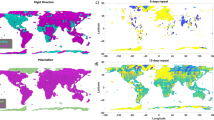Abstract
Hail causes considerable damage to property and agriculture and a simple, unambiguous method of determining which convective storms contain hail would be of great use for short-term weather forecasting, and would also find application in the study of the mechanism of hailstone growth. Previous radar methods of hail detection1–3 have not proved reliable, but here we report results of a new technique based on the measurement of differential reflectivity using dual polarization radar and suggest an additional criterion for hail recognition. Hail is known to occur in vigorous convective storms in which the effective radar reflectivity, Z, measured by conventional radar is high. If the hail reaches the ground it is usually restricted to long narrow swathes4, often about 1 km wide but up to 50 km long, accompanied by surrounding precipitation in the form of heavy rain. The differential reflectivity technique involves comparing the radar reflectivity factor for horizontally (ZH) and vertically (ZV) polarized radiation; the comparison provides a measure of the mean shape of the precipitation particles. Close to the ground the values of Z are high for both hail and heavy rain, but because the large raindrops are oblate and fall with their horizontal diameter greater than the vertical, the value of ZH in the rain exceeds that of ZV. The smaller regions where hail is present can be clearly distinguished from the neighbouring heavy rain because, although individual hailstones may not be spherical, they tumble as they fall and so result in equal values of ZH and ZV.
This is a preview of subscription content, access via your institution
Access options
Subscribe to this journal
Receive 51 print issues and online access
$199.00 per year
only $3.90 per issue
Buy this article
- Purchase on Springer Link
- Instant access to full article PDF
Prices may be subject to local taxes which are calculated during checkout
Similar content being viewed by others
References
Geotis, S. G. J. appl. Met. 2, 270–275 (1963).
Carbone, R. E. et al. Bull. Am. met. Soc. 54, 921–927 (1973).
Barge, B. L. McGill Univ. Sci. Rep. MW-71 (Montreal 1972).
Morgan, G. M. & Towery, N. G. J. appl. Met. 14, 763–770 (1975).
Browning, K. A. Rep. Prog. Phys. 41, 761–806 (1978).
Cherry, S. M. & Goddard, J. W. F. URSI Conf., Bournemouth 49–54 (RAL, 1982).
Hall, M. P. M., Goddard, J. W. F. & Cherry, S. M. Radio Sci. 19, 132–140 (1984).
Marshall, J. S. & Palmer, W. J. Met. 5, 165–166 (1948).
Illingworth, A. J., Goddard, J. W. F. & Cherry, S. M. Am. met. Soc. 22nd Radar Met. Conf., Boston, 145–150 (American Meteorological Society, 1984).
Browne, I. C. & Robinson, N. P. Nature 170, 1078–1079 (1952).
Beard, K. V. & Jameson, A. R. J. atmos. Sci. 40, 448–454 (1983).
Atlas, D., Kerker, M. & Hitschfeld, W. J. atmos. terr. Phys. 3, 108–119 (1953).
Goddard, J. W. F. & Cherry, S. M. Am. met. Soc. 22nd Radar Met. Conf., Boston 352–357 (American Meteorological Society,1984).
Author information
Authors and Affiliations
Rights and permissions
About this article
Cite this article
Illingworth, A., Goddard, J. & Cherry, S. Detection of hail by dual-polarization radar. Nature 320, 431–433 (1986). https://doi.org/10.1038/320431a0
Received:
Accepted:
Issue Date:
DOI: https://doi.org/10.1038/320431a0
Comments
By submitting a comment you agree to abide by our Terms and Community Guidelines. If you find something abusive or that does not comply with our terms or guidelines please flag it as inappropriate.



